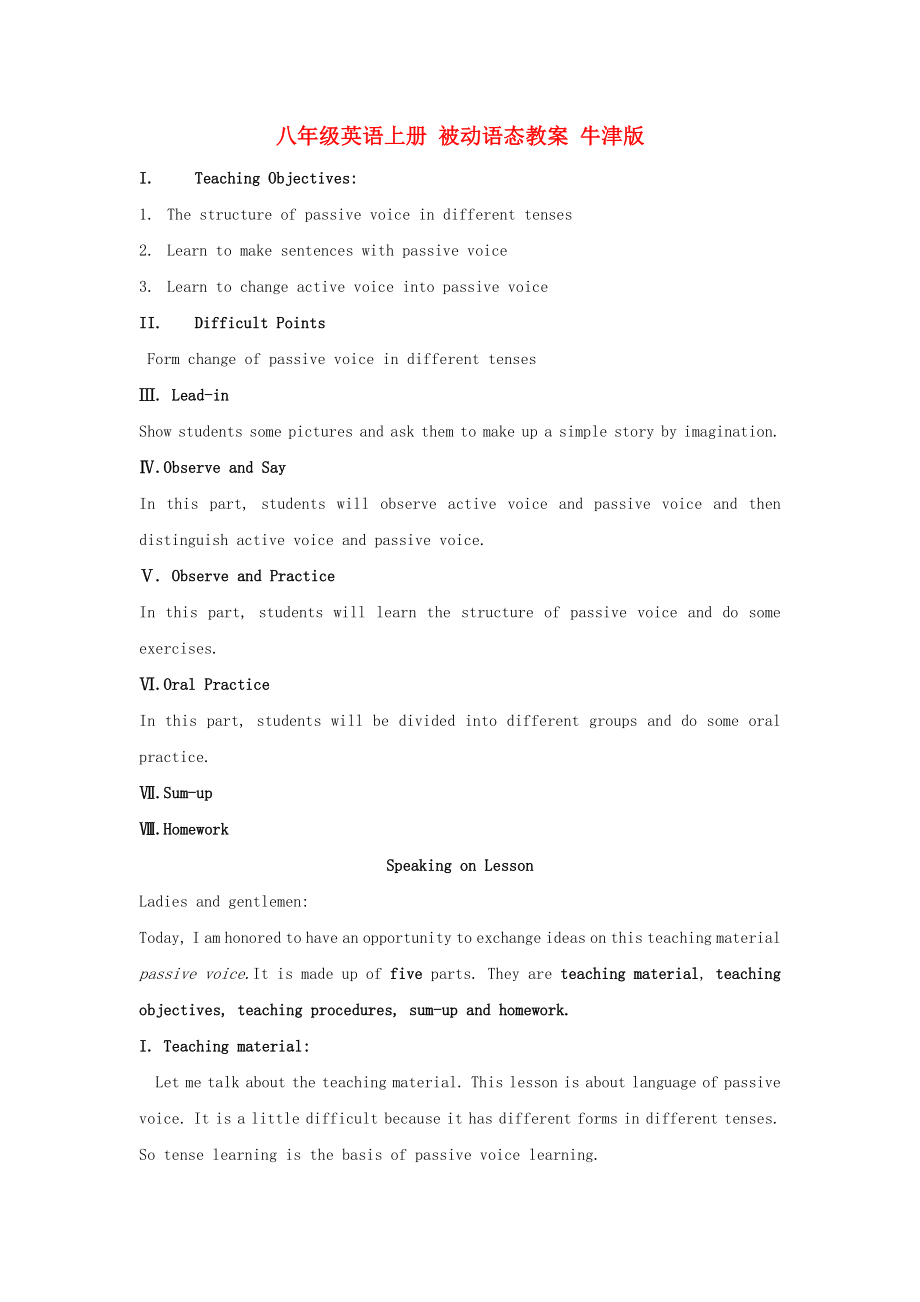《八年級(jí)英語(yǔ)上冊(cè) 被動(dòng)語(yǔ)態(tài)教案 牛津版》由會(huì)員分享��,可在線閱讀��,更多相關(guān)《八年級(jí)英語(yǔ)上冊(cè) 被動(dòng)語(yǔ)態(tài)教案 牛津版(3頁(yè)珍藏版)》請(qǐng)?jiān)谘b配圖網(wǎng)上搜索��。
1���、八年級(jí)英語(yǔ)上冊(cè) 被動(dòng)語(yǔ)態(tài)教案 牛津版
I. Teaching Objectives:
1. The structure of passive voice in different tenses
2. Learn to make sentences with passive voice
3. Learn to change active voice into passive voice
II. Difficult Points
Form change of passive voice in different tenses
Ⅲ. Lead-in
Show students so
2��、me pictures and ask them to make up a simple story by imagination.
Ⅳ.Observe and Say
In this part, students will observe active voice and passive voice and then distinguish active voice and passive voice.
Ⅴ. Observe and Practice
In this part, students will learn the structure of passive voice an
3�����、d do some exercises.
Ⅵ.Oral Practice
In this part, students will be divided into different groups and do some oral practice.
Ⅶ.Sum-up
Ⅷ.Homework
Speaking on Lesson
Ladies and gentlemen:
Today, I am honored to have an opportunity to exchange ideas on this teachin
4����、g material passive voice.It is made up of five parts. They are teaching material, teaching objectives, teaching procedures, sum-up and homework.
I. Teaching material:
Let me talk about the teaching material. This lesson is about language of passive voice. It is a little difficult because it has
5�、 different forms in different tenses. So tense learning is the basis of passive voice learning.
II.Teaching objectives:
According to the first part-teaching material and English new lesson standard, I put forward the following teaching objectives:
1. Knowledge objectives: (1)The structure of
6�����、 passive voice in different tenses
(2) Learn to change active voice into passive voice
2. Ability objectives: Enable Students to make sentences with passive voice
3. Moral objectives: Learn to be active in our lives..
III.Teaching procedures:
Now let’s go to the mos
7�����、t important part--teaching procedures.
In order to realize the teaching process properly and efficiently, under the principle of“regard students as the actors, and the teachers as directors”, I will divide the teaching procedures into 4 steps.
Step 1.Lead–in
In this part, I will show students
8�、 some pictures and ask them to make up a simple story by imagination. In this way, I will bring out the topic.
Step 2. Observe and say
In this step, students will observe active voice and passive voice and then distinguish active voice and passive voice.
Step 3. Observe and practice
In thi
9��、s part, students will learn the structure of passive voice and do some exercises.
Step 4. Oral practice
In this part, students will be divided into different groups and do some oral practice.
IV.Sum-up
In this part, I will summarize what has been learned in this class to form a plete knowledge structure.
V.Homework
1.Write down ten passive sentences .
2,Do some related exercises in exercise book.
 八年級(jí)英語(yǔ)上冊(cè) 被動(dòng)語(yǔ)態(tài)教案 牛津版
八年級(jí)英語(yǔ)上冊(cè) 被動(dòng)語(yǔ)態(tài)教案 牛津版

